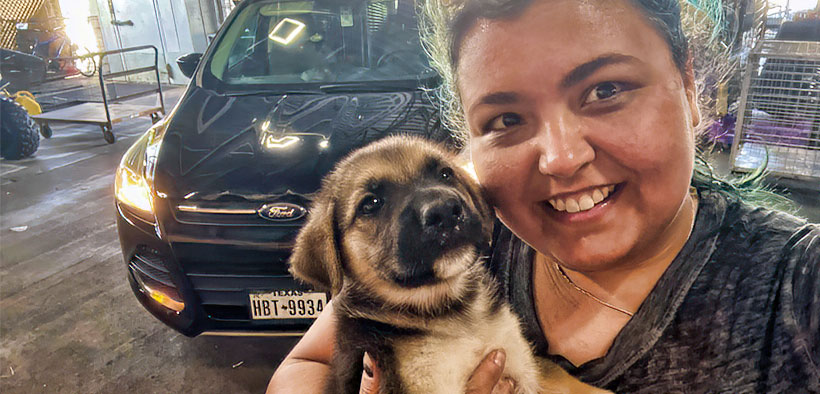Biggie’s back.
Last week searchers located the missing 115-pound half-Great Pyrenees, half-Komondor therapy dog with curly white hair and a long bushy tail. Ten days had passed since he escaped his new home in Canyon Lake’s Summit Vacation & Resort area, where he was training to detect seizures in a woman with epilepsy.
 Biggie was found running near a dry creek bed at the bottom of Pct. 4 County Commissioner Jen Crownover’s property, not far from where he disappeared.
Biggie was found running near a dry creek bed at the bottom of Pct. 4 County Commissioner Jen Crownover’s property, not far from where he disappeared.
Dozens of volunteers, a handful of property owners, neighbors, a drone operator, lost dog posters, a TV news report, an article in MyCanyonLake.com and a clairvoyant helped bring him home.
But it was the advice of an animal trapper in Austin, who never drove to Canyon Lake, that made it happen.
“We knew it had to be him coming to me,” said Biggie’s original owner and breeder, Seguin resident Amber Stubbs-Aydell.
She heeded the advice of Austin realtor Amy Lewis, who serves as board president of Trapping, Rescue and Pet Recovery Service (TRAPRS), a nonprofit Austin-based group of volunteers specializing in the trapping, rescue and discovery of lost and stray pets.
By learning how to think like a scared, lost dog Stubbs-Aydell was able to coax the much thinner, terrified and definitely dirtier dog back into her arms and home to his forever couch in Seguin.
Lewis could predict Biggie’s behavior but was more concerned about his owner’s. Most panic-stricken fur parents run amok when their dogs get lost, screaming and yelling their names, running randomly around neighborhoods and wearing everyone out in the process.
But lost dogs will almost always run and hide, even from their owners.
“I told her when you get there, don’t go out running through the woods, screaming his name,” she said. “Stand there, talk in a normal voice, be quiet and calm, say the words he recognizes, ‘time for dinner, treats, go to the park,’ normal things you say at home when he’s in a safe space.
“You give his brain a chance to refocus on ‘this is familiar, this is safe.’ This is what she did and he came back running to her,” Lewis said.
With Biggie still focused on sheer terror, Stubbs-Aydell got a drone up into the air and canvassed neighbors to see if the dog had shown up on security cameras or loped across their yards.
She left pieces of clothing and pillow cases with her scent in the area, and walked Biggie’s parents around the neighborhood in the hope their smell would comfort him and keep him close.
Some days there were no reports or sightings on security cameras, but there were enough to establish that Biggie was behaving as Lewis explained he would.
“A lot of time we’ll look at satellite maps,” she said. “Dogs like to travel along creeks beds, anything that’s a trail that’s not generally trafficked that much by feet. Pipeline easements, railroad tracks…they might use a hiking trail at night but not during the day.”
Lewis knew that once Biggie found a place where he felt safe he’d settle in.
“People will see them when they’re out looking for food,” she said. “If they’re out a long time they’ll start traveling in circles. How big depends on the dog. One small circle every morning and night. One that takes three days – that’s what we generally see. They’ll have a home base and then they’ll move in a circle around that.”
In Seguin Thursday, a very grateful Stubbs-Aydell advised other pet owners not just to sit around and assume a dog will come back when it’s ready, as many advise.
“Don’t waste time,” she said. “Contact professionals right away.”
Biggie’s size, unusual job and coterie of admirers made him a media darling, but hundreds of other equally beloved cats and dogs go missing each year in far-flung Comal County and many don’t make it home.
Their only chance is being spotted on Facebook or featured on the highly popular nextdoor.com, where neighbors talk to each other.
Canyon Lake is home to devoted animal rescuers who have set up Facebook pages dedicated to finding lost and stray pets in the area, including Comal County lost and found dogs, Group for Comal County Lost and Found Dogs, and Comal County Cats all over the place.
While social media presence helps enormously – Lewis says it’s always good to turn out “eyes” when a pet is missing – it isn’t the only answer.
TRAPRS
TRAPRS trains owners to run in the right direction.
“Once they’re in flight mode it’s difficult to get them out of that,” Lewis said. “Dogs make extraordinarily bad decisions when they’re out there…Your going out there screaming for them isn’t helpful. All they’re going to do is run the other way.”
Every pet deserves a chance at a better life.
TRAPRS catches the uncatchable, taking animals from life on the streets into safe homes – “turning fear into love” and advising people scared pet owners how to do the same.
The nonprofit helps locate missing cats or dogs with active, recent or consistent sightings within the past 72 hours: A dog that appears every couple of days at the same spot, a cat spotted on a neighbor’s porch camera, or a dog with multiple sightings within a general area, as in Biggie’s case.
TRAPRS also steps in if animal control won’t because a stray is injured, fearful or skittish.
The group’s sub-specialty is finding animals that have gone missing as a result of a car accident in the past 24 to 48 hours, something that happens a lot. Animals escape all the time due to minor fender-benders when owners get out of vehicles to argue or exchange information.
Lewis said TRAPRS, which has limited resources, serves the Austin area. But she was prepared to make an exception and drive to Canyon Lake and attempt to trap Biggie, who’d been spotted by neighbors and caught on security cameras.
She prefers that any interested Canyon Lake residents come to her. It only takes a half hour to learn how to use a box trap.
“If all they do is trap one or two dogs in a general area in a year, it keeps those things off my plate so I can do more complicated areas,” Lewis said.
On its website, TRAPRS provides links to videos, suggested flyers, and provides a checklist of things to do if a cat or a dog goes missing – it’s not the same for each.
Tales from a Trapper
Lewis said Jack Russell terriers were her gateway drug to trapping.
She began fostering the high–energy little dogs while volunteering with Austin Lost and Found Pets.
Seven years ago, after doing “everything wrong” when one of her Jack Russells escaped, she was intrigued by the stories of an experienced rescue trapper working with the rescue group.
At that time, trapping pets and strays was fairly new to animal rescue. Most professional trappers either focused on coyotes or worked for city or county animal control departments. Cat trapping was limited to trap-neuter-release programs designed to curb feral populations.
But advances in technology like game cameras that send digital pictures to cell phones, and laser technology that remotely shuts trap doors, suddenly made pet trapping easier for everyday animal rescuers with little training or expertise.
Lewis said her first attempt at trapping scared dogs involved two fearful scruffy terriers who’d been dumped in an east Austin neighborhood. Neighbors said they’d been living on the street for several months.
It took her two weeks to snag them. One of them now lives with her. The other was adopted by a relative.
Lewis was hooked. She graduated from using ‘box traps’ to catch smaller animals to setting up large, heavy and very expensive ‘Missy Traps’ for larger dogs.
“We’ve even caught a coyote purposely in our Missy Trap,” she said. “It was in a fancy neighborhood in west Austin. A young female got her foot stuck in a trap and took off running, dragging four pounds of metal through the woods. It was starving to death and had mange from lack of nutrition. We spent two weeks figuring out how to trap her.”
Once they did, the coyote was transported to Wildlife Rescue & Rehabilitation in Kendalia. The animal’s leg was amputated and she was released back into the wild a month later.
Two weeks ago, Lewis said she worked with an owner whose dog escaped and had been living on the streets for a week. The owner knew where the dog was, but it was too afraid to come when called.
Communicating by text, she directed the owner to sit on the ground in the area where the dog had been spotted and wait patiently, speak quietly, and avoid direct eye contact with the animal, as excruciatingly difficult as that seemed.
“We let her have time,” Lewis said. “It took 45 minutes. She would inch closer, then five feet closer. She was sitting there howling at him. She knew something there that hadn’t convinced her brain yet.”
The trapper’s own home is filled with the “least adoptable’’ terrified-and-skittish dogs she’s rescued over the years.
She uses a gate to create an ‘air lock’ at her front door so they can’t escape.
“It’s just a reframing of the way you do things to keep them safe,” Lewis said. “An ounce of prevention is worth a pound of cure.”
And yet … one of them managed to slip around her unsuspecting parent’s leg during a Christmas visit.
Lewis followed her own advice. She lay down on the sidewalk (while still in a nightgown) and spoke quietly to her quivering little terrier mix.
It worked.
Last week, Lewis pulled over and got out of her car to rescue another terrified dog running around a busy Austin street.
She was able to grab the animal’s choke chain before it executed an “alligator roll” and broke two of her fingers by tightening the thick links around them.
Undaunted, Lewis called her team for help and blocked a cul-de-sac where the dog fled, speaking quietly through her pain.
When other trappers arrived a half hour later the dog took off again, jumping several cyclone fences before it was trapped with a snare.
“He was visiting Grandma,” Lewis said. “They live in Kyle. She left him in the yard and he jumped out. He was not fixed. This is a big problem with people in the country. If your dog is not fixed he will do anything he can to get to (a dog in heat) them. If you want to keep your dog at home, fix your dog. It’s not going to solve all of your problems but it will help immediately.”
If your dog does run off, grab the car keys. Don’t try to chase it down the road on foot.
“They’re going to be less nervous and less recognizing of the car than you and plus they can run faster,” she said. “Try to get in front of them. At that point, if it hasn’t been a fear response it probably will feel like playing a game. Take a toy. I have squeaky toys in my car so I can convince them we’re playing a game.”
Lewis also keeps cans of Vienna sausages in her car, which she describes as ‘crack’ for dogs.
“It’s counterintuitive, she said. “Most people will chase a dog and scream their names. If the dog is scared they’re going to run from you. Even in a foot race the dog can run faster. Unless you can corner them, and chase them into a confined area, you are not going to win.”
So don’t run.
Go home, gather scent items and plop them in a straight line heading in the dog’s direction. Start posting on NextDoor and Facebook.
“Most dogs won’t go super-far super-fast,” Lewis said. “Most dogs will stay in the general area at least at first.”
Instead of worrying about plastering a neighborhood with signs – there’s time for that later – stick a big sign in the yard saying ‘lost dog belongs here.’ Place signs at the entrances and exits of neighborhoods.
“You need all those eyes out working for you,” she said.
In most cases, missing dogs will be found within 24 hours. If they’re not, start posting signs everywhere – but don’t reveal the dog’s name.
“We don’t want people out there shouting the dog’s name,” Lewis said.
Don’t offer a reward either, she cautions, unless you own a ‘high-dollar’ dog like a Frenchie or a pug who may have been stolen just for that reason.
“In general if you’ve posted a big reward, people are going to try and find the dog and all they’re going to do is the wrong thing, screaming the dog’s name and scaring your dog away,” Lewis said. “People think, if I offer $5,000 someone will find my dog. This encourages people who don’t know what they’re doing to scare your dog.”
Strangers should only be “looking” during the course of their normal daily routine.
If a missing dog is – to its way of thinking – “safe” in a hiding space, yelling and screaming by people it doesn’t know will only drive it further afield.
The good news is most dogs, like Biggie, will be found if owners follow her advice.
The same isn’t as true for cats. People are more used to seeing cats lying around on porches or ambling through neighborhoods and aren’t as emotionally invested in helping them as they are dogs.
Nobody picks up a phone to report a cat meandering down a street.
Then there are coyotes. In rural Comal County, felines are tasty treats for the 45-pound predators, who don’t mess with dogs weighing over 20 pounds.
Unfortunately, a lot of cats are gone before we can do much to help,” Lewis said. “We can trap, but we can’t find.”
TRAPPRS will try, though.
“They’ll see it under a house or in a storm drain but can’t get them and then we go out and trap in that case,” she said.
To contact TRAPRS call the hotline: 1-844-287-2777.




